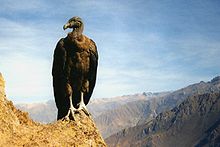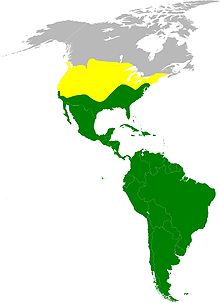新大陆鹫类
| 美洲鹫科 化石时期:
| |
|---|---|

| |
| 安地斯神鹫 | |
| 科学分类 | |
| 界: | 动物界 Animalia |
| 门: | 脊索动物门 Chordata |
| 纲: | 鸟纲 Aves |
| 目: | 鹰形目 Accipitriformes |
| 科: | 美洲鹫科 Cathartidae Lafresnaye, 1839 |
| 属 | |

| |
新大陆鹫类,又称新世界秃鹫或新域鹫,是属于美洲鹫科(学名:Cathartidae)的鸟类。[1]当中包含了在美洲温带生活的5种秃鹫及2种神鹫。除了美洲鹫属外,所有其下的属都是单型的。
新大陆鹫类在基因上与外表相似的旧大陆鹫类并非近亲,牠们之间的相似性是来自趋同演化,这些类群被统称为鹫类。[2]牠们在新近纪都是广泛分布在旧世界及北美洲的。
美洲鹫是吃腐肉的,很多时都是吃已死去的动物尸体。新大陆秃鹫有良好的嗅觉,但旧大陆秃鹫却是凭视觉来寻找尸体。牠们的特征是头上完全没有羽毛。
生物学
分类及演化
新大陆鹫类包含了5个属及7个物种,5个属当中只有美洲鹫属不是单型的。牠们的分类如下[3]:
- 黑美洲鹫属(Coragyps)
- 黑美洲鹫(C. atratus)
- 美洲鹫属(Cathartes)
- 红头美洲鹫(C. aura)
- 小黄头美洲鹫(C. burrovianus)
- 大黄头美洲鹫(C. melambrotus)
- 加州兀鹫属(Gymnogyps)
- 加州神鹫(G. californianus)
- 康多兀鹫属(Vultur)
- 安地斯神鹫(V. gryphus)
- 王鹫属(Sarcoramphus)
- 王鹫(Sarcoramphus papa)
新大陆鹫类传统上是作为一个科分类在隼形目中。[4]但是于20世纪末,一些学者认为牠们的染色体组型图[5]、形态[6]及行为[7]更为像鹳。故此一些文献将牠们分类在鹳形目中,甚至认为牠们是鹳科内的一个亚科。[8]不过另有一些意见这种分类过于简化[9][10],而基因证据亦推翻了这个分类。[11][12]现时却有一种趋势将新世界鹫类提升为一个目,称为美洲鹫目,与猛禽或鹳没有近亲的关系。[13]美国鸟类学者协会(American Ornithologists' Union)于2007年将北美洲的美洲鹫科再次分类在隼形目中[14],而草拟将南美洲的美洲鹫科定为地位未定,有可能属于隼形目或美洲鹫目。[15]
美洲鹫科的学名是来自希腊文的“净化者”之意。
形态
新大陆鹫类一般都很大,由小黄头美洲鹫的56-61厘米至加州神鹫及安地斯神鹫的120厘米长。羽毛主要是黑色或褐色,间中有些白纹。所有的物种头部及颈部都没有羽毛。[16]一些皮肤上有鲜艳的颜色,如王鹫就有色彩缤纷的肉冠。
新大陆鹫类都有长而且阔的双翼,尾巴坚硬,适合翱翔。[17]牠们比其他鸟类更适合翱翔。[18]双脚有爪,但很脆弱,并不适合抓东西。[19]前趾较长,底部有细小的网状组织。[20]由于牠们没有鸣管[21],故其叫声只限于咕噜声及嘶嘶声。[22]
牠们的喙稍呈钩状,与其他猛禽比较则较弱。[19]这是由于牠们的喙是用来撕开腐肉,而非鲜肉。[18]鼻孔呈卵状,有蜡膜。[23]鼻腔并没有分隔,故可以从一边的鼻孔看穿另一边。[24]眼睛很突出,但不像鹰般有眉骨遮蔽。[23]黑美洲鹫属及美洲鹫属有单一但不完整的上睫毛及两行下睫毛,而加州兀鹫属、Vultur及王鹫属则完全没有睫毛。[25]
新大陆鹫类会在脚上排泄,来帮助降低体温。由于鹳亦会这么做,故这亦成为牠们之间紧密关系的论点。[4]
食性

新大陆鹫类都是吃腐肉的。虽然牠们大部分的饮食都是腐肉,一些成员如黑美洲鹫都曾被发现猎杀猎物。牠们也会吃果实、蛋及垃圾。美洲鹫属中有一种不寻常的特征,就是牠们有敏锐的嗅觉,用来寻找尸体。牠们凭着尸体发出的乙硫醇来确定位置。牠们脑部的嗅叶比其他动物为大。[26]其他物种如黑美洲鹫及王鹫的嗅觉并不灵敏,只靠视觉,或有时甚至是跟随美洲鹫属或其他吃腐肉的动物来寻找食物,[21]例如没有嗅觉的加州神鹫。
新大陆鹫类的头部及颈部没有羽毛是一种对卫生产生的适应性:可以阻止细菌从尸体藏在羽毛中,另外皮肤亦可以被太阳照射而消毒。[27]
繁殖
新大陆鹫类不会筑巢,牠们会在光秃的地方生蛋。牠们每次会生1-3颗蛋,这视乎不同物种而定。[16]雏鸟出生时没有羽毛,于2-3个月后才长出。[22]双亲会以反哺形式来喂养雏鸟。[23]
与人类关系
文化
黑美洲鹫及王鹫在玛雅古抄本作为古代文字出现。当中以王鹫最为普遍。[28]王鹫的图腾从其肉冠及眼睛可以清楚分辨。[28]牠们有时被描绘成一个鸟头人身的神祇。[28]根据玛雅传说,这个神祇是在人类与其他神祇之间传递讯息。牠们在玛雅历法中代表每月的第13日。[28]在玛雅古抄本中,黑美洲鹫一般与死亡或是猛禽有关,而牠们的图腾代表攻击人类。黑美洲鹫就没有像王鹫般的宗教意味。虽然一些图腾明显显示黑美洲鹫相通的鼻孔及钩状喙,但有一些则是从没有王鹫的肉冠来估计是黑美洲鹫。[28]
危害及保育
加州神鹫是濒危物种。[29]于1987年就已饲养了所有野生的加州神鹫来确保其生存。[29]于2005年,只有127只野生的加州神鹫。
已灭绝物种及化石
异鹫是一种与新大陆秃鹫有关的已灭绝动物,在美洲是新大陆秃鹫的对手。新大陆秃鹫在史前时代亦有在欧洲出现,甚至有可能在当地演化。风神鹫Aiornis incredibilis的外表可能像现今的鸟类。不过牠们并非近亲,而是并行演化的例子,而异鹫比秃鹫更具掠食性。[32]
美洲鹫科的化石历史颇为大量,但较为混淆。很多化石不论有可能是或不是新大陆秃鹫都被认为是此科的早期成员。自新近纪就没有明确的化石纪录,而分子分析的结果却更为模棱两可。[33]
美洲鹫科于上新世或更新世有高度的多样化,可与现今的旧大陆秃鹫媲美。已灭绝的属有:
- 异乡鹫属 Diatropornis
- 幽灵鹫属 Phasmagyps
- 巴西鹫属 Brasilogyps
- 粗壮鹫属 Hadrogyps
- 上新鹫属 Pliogyps
- 秘鲁鹫属 Perugyps
- 树鹫属/扶桑鹫属 Dryornis
- 巨鹫属 Aizenogyps
- 沥青鹫属 Breagyps
- 热罗诺鹫属 Geronogyps
- 温厄鹫属 Wingegyps
- 副王鹫属 Parasarcoramphus
于蒙古、美国、阿根廷及古巴发现的化石并未曾分类。现时亦有发现很多与现存物种同属的化石。
在欧洲发现早期新近纪的化石可能是属于新大陆秃鹫,称为Plesiocathartes。另一方面,高鸟科的新兀鹫曾经被认为是一种特别的新大陆秃鹫。
参考
- ^ 马鸣, 等. 新疆兀鹫. 北京: 科学出版社. 2017.
- ^ Wink, M. Phylogeny of Old and New World vultures (Aves: Accipitridae and Cathartidae) inferred from nucleotide sequences of the mitochondrial cytochrome b gene. Zeitschrift für Naturforschung. 1995, 50 (11-12): 868–882.
- ^ 郑光美主编 《世界鸟类分类与分布名录》 2002年 科学出版社 ISBN 7-03-010294-0
- ^ 4.0 4.1 Sibley, Charles G., and Jon E. Ahlquist. Phylogeny and Classification of Birds: A Study in Molecular Evolution. Yale University Press. 1991. ISBN 0-300-04085-7.
- ^ de Boer, L. E. M. Karyological heterogeneity in the Falconiformes (Aves). Cellular and Molecular Life Sciences. 1975, 31 (10): 1138–1139. doi:10.1007/BF02326755.
- ^ Ligon, J. D. Relationships of the cathartid vultures. Occasional Papers of the Museum of Zoology (University of Michigan). 1967, 651: 1–26.
- ^ König (1982)
- ^ Sibley, Charles G. and Burt L. Monroe. Distribution and Taxonomy of the Birds of the World. Yale University Press. 1990. ISBN 0-300-04969-2.
- ^ Griffiths (1994)
- ^ Fain & Houde (2004)
- ^ Cracraft, J., F. K. Barker, M. Braun, J. Harshman, G. J. Dyke, J. Feinstein, S. Stanley, A. Cibois, P. Schikler, P. Beresford, J. García-Moreno, M. D. Sorenson, T. Yuri, and D. P. Mindell. Phylogenetic relationships among modern birds (Neornithes): toward an avian tree of life. J. Cracraft and M. J. Donoghue, eds. (编). Assembling the tree of life. New York: Oxford University Press. 2004: 468-489.
- ^ Gibb, G. C., O. Kardailsky, R. T. Kimball, E. L. Braun, and D. Penny. Mitochondrial genomes and avian phylogeny: complex characters and resolvability without explosive radiations. Molecular Biology Evolution. 2007, 24: 269–280 [2008-08-19]. (原始内容存档于2008-12-09).
- ^ Ericson, Per G. P.; Anderson, Cajsa L.; Britton, Tom; Elżanowski, Andrzej; Johansson, Ulf S.; Kallersjö, Mari; Ohlson, Jan I.; Parsons, Thomas J.; Zuccon, Dario & Mayr, Gerald. Diversification of Neoaves: integration of molecular sequence data and fossils (PDF). Biology Letters. 2006. doi:10.1098/rsbl.2006.0523. (原始内容 (PDF)存档于2006-11-08).
- ^ Check-list of North American Birds. American Ornithologists' Union. 1998–2006 [2007-04-09]. (原始内容存档于2007-12-11).
- ^ Remsen, J. V., Jr., C. D. Cadena, A. Jaramillo, M. Nores, J. F. Pacheco, M. B. Robbins, T. S. Schulenberg, F. G. Stiles, D. F. Stotz, and K. J. Zimmer. A classification of the bird species of South America. American Ornithologists' Union. 2007-04-05 [2007-04-10]. (原始内容存档于2009-03-02).
- ^ 16.0 16.1 Zim, Herbert Spencer; Robbins, Chandler S.; Bruun, Bertel. Birds of North America: A Guide to Field Identification. Golden Publishing. 2001. ISBN 1-58238-090-2.
- ^ Reed, Chester Albert. The Bird Book: Illustrating in Natural Colors More Than Seven Hundred North American Birds. The University of Wisconsin. 1914.
- ^ 18.0 18.1 Ryser Fred A. & A. Ryser, Fred Jr. Birds of the Great Basin: A Natural History. University of Nevada Press. 1985. ISBN 0-87417-080-X.
- ^ 19.0 19.1 Krabbe, Niels & Fjeldså, Jon. Birds of the High Andes. 1990. ISBN 87-88757-16-1.
|journal=被忽略 (帮助) - ^ Feduccia, J. Alan. The Origin and Evolution of Birds. Yale University Press. 1999: 300. ISBN 0-226-05641-4.
- ^ 21.0 21.1 Kemp, Alan, and Ian Newton. New World Vultures. Christopher Perrins, ed. (编). The Firefly Encyclopedia of Birds. Firefly Books. 2003. ISBN 1-55297-777-3.
- ^ 22.0 22.1 Howell, Steve N.G., and Sophie Webb. A Guide to the Birds of Mexico and Northern Central America. New York: Oxford University Press. 1995: 174. ISBN 0-19-854012-4.
- ^ 23.0 23.1 23.2 Terres, J. K. & National Audubon Society. The Audubon Society Encyclopedia of North American Birds Reprint of 1980 edition. 1991. ISBN 0-517-03288-0.
- ^ Allaby, Michael. The Concise Oxford Dictionary of Zoology. Oxford: Oxford University Press. 1992: 348. ISBN 0-19-286093-3.
- ^ Fisher, Harvey I. The Pterylosis of the Andean Condor. Condor. 1942, 44 (1): 30–32 [2008-08-19]. (原始内容存档于2021-10-20).
- ^ Snyder, Noel F. R. & Snyder, Helen. Raptors of North America: Natural History and Conservation. Voyageur Press. 2006. ISBN 0-7603-2582-0.
- ^ Sarcoramphus papa. Who Zoo. [2007-09-11]. (原始内容存档于2014-09-01).
- ^ 28.0 28.1 28.2 28.3 28.4 Tozzer, Alfred Marston & Allen, Glover Morrill. Animal Figures in the Maya Codices. Harvard University. 1910.
- ^ 29.0 29.1 BirdLife International. Gymnogyps californianus. The IUCN Red List of Threatened Species 2006. [4 September 2006].
- ^ BirdLife International. Vultur gryphus. The IUCN Red List of Threatened Species 2004. [23 September 2007].
- ^ BirdLife International (2004). 2001 Categories & Criteria (version 3.1) (页面存档备份,存于互联网档案馆). International Union for Conservation of Nature and Natural Resources. Downloaded 2007-11-09.
- ^ Campbell, Kenneth E. Jr. & Tonni, E. P. Size and locomotion in teratorns (PDF). Auk. 1983, 100 (2): 390–403 [2008-08-19]. (原始内容 (PDF)存档于2012-07-04).
- ^ Avise, J. C.; Nelson, W. S. & Sibley, C. G. DNA sequence support for a close phylogenetic relationship between some storks and New World vultures (PDF). Proc. Natl. Acad. Sci. USA. 1994, 91 (11): 5173–5177 [2008-08-19]. doi:10.1073/pnas.91.11.5173. (原始内容存档 (PDF)于2007-10-31).
外部链接
| ||||||||||||||||||||||||||||||||||
|
Text is available under the CC BY-SA 4.0 license; additional terms may apply.
Images, videos and audio are available under their respective licenses.

